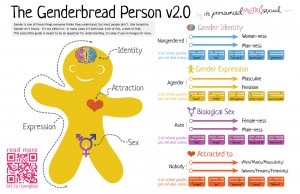Breaking news from last night: MTV’s Faking It – Season 2 (premieres Tuesday, September 23rd) will feature an intersex character! From The Hollywood Reporter:
On Faking It, Bailey De Young portrays Lauren, a hyper-feminine bitchy teen who is the sister (by marriage) to Rita Volk‘s Amy, who in season one, faked a lesbian relationship with her best friend Karma (Katie Stevens), to move up the social ladder at an Austin high school.
Season one ended with a cliffhanger for Lauren, who flipped out after rumors started flying about mysterious pills she was taking regularly. The season two premiere will reveal that Lauren regularly takes hormones and was born with Androgen Insensitive Syndrome, a type of intersex condition that means she was born with male chromosomes but develops as a female.
As many of you know, my YA contemporary book None of the Above also features a main character with Androgen Insensitivity Syndrome, or AIS. More importantly, the consultants that MTV worked with from Advocates for Informed Choice and Inter/Act (their youth branch – check out their amazing FAQ here) are some of the incredible people I met at this year’s AIS-DSD conference. Their board member Arlene Baratz was one of the people who vetted None of the Above, and offered a lovely blurb:
“Smartly and compassionately written for a young adult audience, None of the Above puts a new twist on the theme of adolescent difference and acceptance.”
-Arlene Baratz MD (Moderator, Androgen Insensitivity Syndrome- Differences of Sex Development Parents Group www.aisdsd.org)
I am so, so psyched that MTV is putting a spotlight on intersex, because after I sold my book and started to tell my family and friends about it, I realized the huge gap in knowledge about intersex even among medical professionals. There is so much work still to be done to create intersex awareness. So below, the top 5 myths I’ve had to debunk in the year since my book sold:
Myth #1: Intersex = Transgender
This is a very common misconception. To the point where, when I told a doctor friend that I was going to an intersex conference, he laughed and said “Well, it’s appropriate then that it’s in San Francisco!” Then he realized his mistake.
Let’s talk about sex (and the difference between sex and gender). Ladies and gentleman, I present the Genderbread Person:

A person’s sex refers to ones biology – their sexual anatomy at birth – which sometimes correlates with ones chromosomes, but not always. Besides the usual XX and XY chromosomal set, people can be XXY, XO, and even have different sets of chromosomes in different cells.
Gender, however, refers to how a person perceives oneself and wishes to be identified on the gender spectrum.
Intersex individuals are people born with either external or internal sex characteristics that are different than the “typical” male or female. Transgender individuals are people who are born “typically” male or female, but who do not identify as their birth gender (the stereotypical woman trapped in a man’s body). They may often use medical intervention (hormones and surgery) to help them match their identified gender with their birth gender.
Because of these definitions, you can actually be both intersex AND transgender. But not all intersex individuals are transgender.
Myth #2: Intersex people are born with both vaginas and penises
One of the reasons for the general lack of awareness about intersex, even among medical professionals, is that it is an incredibly complex, nuanced field of study involving over 30 biological conditions. The term intersex covers a spectrum of medical conditions and chromosomal differences ranging from hypospadias (when someone’s pee hole isn’t where it’s supposed to be), to conditions where people have one testis and one ovary. In the case of people with AIS, they have XY chromosomes and look female on the outside, but don’t have uteruses and have testes instead of ovaries.
There are even some types of intersex that haven’t been fully diagnosed, in that they don’t fit into the exact cluster of characteristics that match a known syndrome. These people are literally one of a kind!
More important than there being a range of biological expressions of intersex is that people experience intersex differently. So the main character in None of the Above has a very, very different experience than that of the character in Jeffrey Eugenides’ Middlesex, or Abigail Tarttelin’s Golden Boy.
Myth #3: Intersex is a rare condition
Depending on how wide your definition of intersex is, the prevalence of intersex conditions ranges from 1 out of 100 people, to 1 in every 2,000. The now-defunct Intersex Society of North America has a great breakdown of the statistics on their website (as well as a lively discussion on the difficulties inherent to coming up with the aforementioned statistics).
Even if you take the 1 in 2,000 number, that means that intersex individuals are as common as redheads.
Myth #4: Intersex should be surgically corrected
This is one of the most damaging myths that exists. In fact, for many years, it was a reality in the medical profession. As recently as a decade ago, parents of children born with intersex or ambiguous genitalia were counseled to have their babies undergo surgery to “normalize” their sexual characteristics. This, however, often led to complications. Kids grew up with horrible consequences of being operated on so early.
Because of such activist groups like the Intersex Society of North America and Accord Alliance, times are changing, albeit slowly. Surgery is no longer the default. But it still happens, as the case of M.C., a 8-year-old ward of South Carolina who was born intersex and subjected to feminizing surgery as a toddler. He now identifies as male.
Myth #5: The general public isn’t interested in knowing more about intersex conditions
When I first wrote my novel, I was scared. What if no one wanted to buy it? What if intersex was considered too risky? A few people passed on it due to concerns over how well it would sell. But a number of people were interested in it. Really interested. And I shouldn’t have been surprised. Middlesex was a bestseller, and an Oprah’s Book Club selection. Intersex characters have made it onto House, and Grey’s Anatomy.
A lot of people are fascinated by the subject of intersex once they come across it – the problem is that a lot of people don’t even know that they exist. As Accord Alliance says, intersex “has been largely invisible to many people.”
Why do so few people know what intersex is? Like many things related to sex, there has been a veil of secrecy and shame surrounding intersex conditions. It’s the goal of None of the Above – and that of MTV’s Faking It and Inter/Act Youth – to break through this veil.
Here’s the trailer for Season 2 of Faking It. I hope you check it out – I know I will!

Ilene, thanks for posting this excellent information!
It’s been awhile since I read your manuscript, so this little refresher was very useful. I think it’s an excellent thing for your book that this TV show will be featuring an intersex character right around the time your book comes out. I mean, it’s good to have the public educated about this condition … but book sales are good, too. 😉
Great article thank you for alll your support of our community!
Kimberly
Executive Director of Advocates for Informed Choice
AIS-DSD Support Group Board Member
Of course, Kimberly and Arlene! It’s a pleasure and an honor to work with you to increase #IntersexAwareness!!
What an excellent post. Could you tell your publisher to speed things up a bit? I still can’t WAIT for NONE OF THE ABOVE to come out! 😉
Aw, thank you Anita! ARCs have just become available, so keep your eyes peeled on Edelweiss!
I have been wondering about that show. Now I’m interested in that, and even more so in your book!